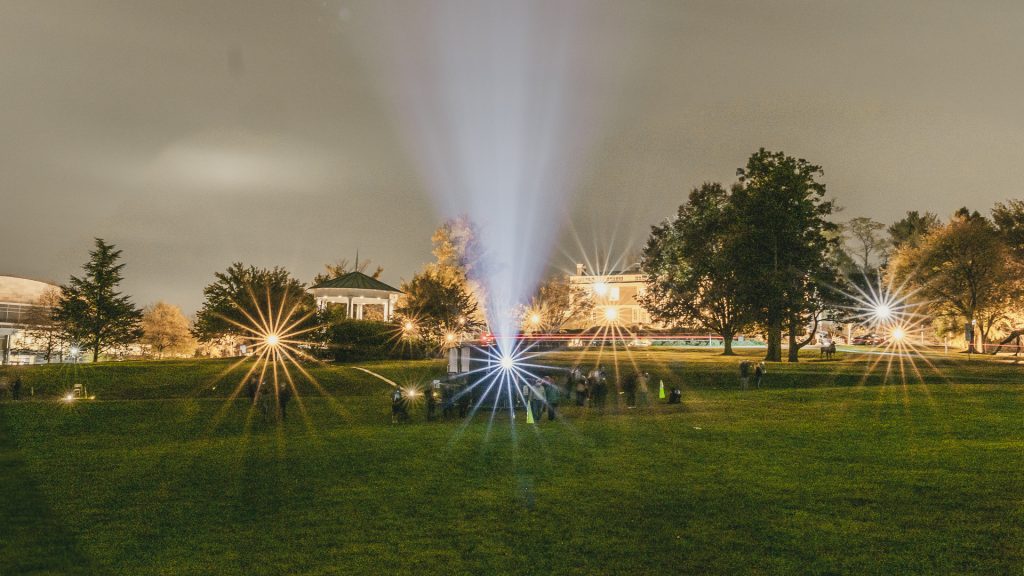Outdoor art installation honors artists shaping our community.
August 21, 2020
By Mary Murdock
Picture this: as dusk falls, you walk onto the rolling green of the Strathmore grounds to see the moving, luminescent faces of boundary-pushing artists looking back at you from the trees. This October, Strathmore welcomes you back to our campus with an outdoor art installation that highlights artists’ essential work as contributors to the community. Australian artist Craig Walsh’s Monuments: Creative Forces will feature moving portraits of artists projected into the night sky, transforming trees into sculptural monuments and honoring the transformative work of the artists themselves.
REDEFINING MONUMENTS
When we think of a monument, many picture a marble statue of a man from another time or, perhaps, a pillar. Walsh’s Monuments challenges that mental picture, expanding it to celebrate living members of our community, and swapping out chiseled marble for an ethereal face in the leaves of a tree. “The conversation around monuments is front and center right now and while an essential dialogue about the appropriateness of many monuments continues, visitors to the DC area also know first-hand the power of visiting installations that reminds us of our better angels,” remarks Strathmore Artistic Director Joi Brown.
Monuments leads us to question who gets honored in our public spaces and what kind of work is viewed as worthy of being honored with a public monument. Walsh uses the installation to tell “the sort of stories that won’t be turned into permanent monuments, given the political, economic, and social status that enables those permanent monuments to exist.” Every day, people make contributions to our community that will never be recognized by a marble statue in a city center but that nevertheless are the bedrock of our society. Local artists, for example, may have their work celebrated in a gallery, but rarely do they get publicly uplifted as people who have made a significant contribution to the community. “Let’s tell their story,” says Walsh, “Let’s make monuments to those people.”
At Strathmore, Monuments will pay tribute to six artists whose work is changing the shape of our community in fundamental and essential ways. “A ‘Force of Nature’ can change the shape of the world,” says Brown. “We celebrate artists who improve and transform the world around them through artistic and community endeavors.” The artists featured will be chosen through a nomination and selection process in which a diverse panel of community and arts leaders will evaluate artists’ work as a contribution to transformation, unity, equity, and social imperatives within the community. Their portraits will be monumentalized as video projections created by Walsh. Through the installation, visitors will get to know the artists as humans first and foremost, preceding the art and achievements that have shaken the ground beneath them.
RECONNECTING WITH OUR SPACES
“How does the environment relate to the human condition?” This is a question that Walsh asked himself early on in the process of developing Monuments, which premiered in 2014 at Australia’s White Night Festival. It sparked a traveling installation, temporarily monumentalizing the unsung heroes of communities around the world. “All my work is temporal,” notes Walsh, “and part of the objective of making it temporal is to avoid the politics defining public work and public spaces.” This temporality, combined with Walsh’s dedication to site-responsive work, makes the installation completely unique to each community that it’s built in during a specific moment in time.
Though Monuments has been years in the making, it is particularly resonant within our current cultural and historical moment. “By projecting these portraits . . . we can learn a lot about our relationship to [public] spaces,” says Walsh. This is a relationship that has changed quite markedly over the last few months, during which public spaces have been altered or even shut down to prevent the spread of disease. Strathmore’s campus has been one such space, and Monuments is a significant step in reimagining how the nonprofit arts venue can continue to pursue the mission of creating dynamic arts experiences that cultivate connections within the community. Walsh remarks on the fact that Monuments may be an ideal arts experience for this time, saying that “In a big public space, you can [physically distance] quite easily.” The nature of the installation is also such that “you can be in different parts of the space and have different experiences,” allowing visitors to move about the venue while engaging with the art in an ideal way.
“This moment has taken us back to some important basics—among them, time with loved ones, time in nature, and artistic sources of individual inspiration,” Brown says. “As we navigate this time, we want Strathmore’s campus to be a place of healing and inspiration.” Through Monuments, not only will the Strathmore campus become a space for safe connection between members of our community, but also a space for the veneration of community itself, and the essential role of art within it.
